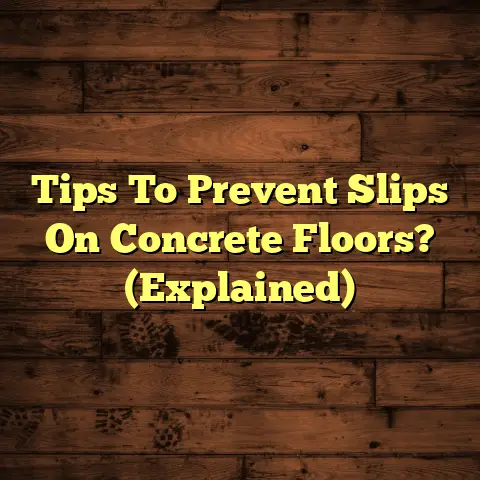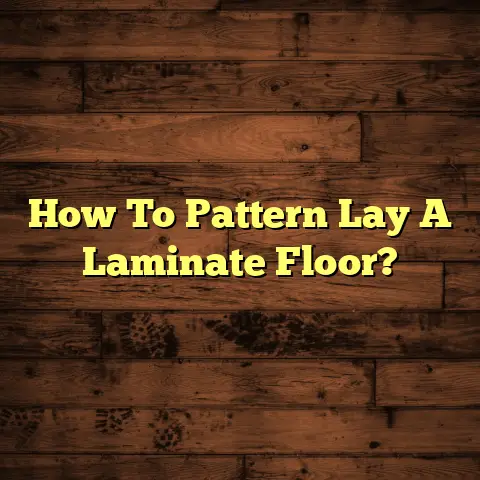Under Hardwood Floors: What Goes There? (1 Secret!)
As a flooring contractor with years of experience, I’ve seen firsthand how much families care about creating safe and healthy homes.
And rightly so!
Think about your kids for a moment. Where do they spend most of their time?
On the floor, right?
Playing with toys, building forts, even just sprawling out to read a book.
That floor is their playground, their canvas, their comfort zone.
As parents, we worry about allergens, safety hazards, and whether our homes are truly nurturing environments for our children.
That’s where hardwood floors come in.
They’re beautiful, durable, and a popular choice for families. But have you ever stopped to think about what’s underneath those gleaming planks?
It’s more important than you might realize!
Today, I’m going to pull back the curtain and reveal a secret about what lies beneath your hardwood floors.
It’s a secret that could impact your children’s health and well-being.
So, stick with me, and let’s uncover the truth together!
Section 1: The Appeal of Hardwood Flooring
1.1. Aesthetic and Practical Benefits
Let’s face it, hardwood floors are stunning.
They add warmth, character, and a touch of elegance to any home. But their appeal goes beyond just looks.
Hardwood is incredibly durable, making it a practical choice for busy families.
It can withstand the wear and tear of daily life, from kids running around to pets scratching and everything in between.
Plus, hardwood floors are relatively easy to clean. A quick sweep or mop is usually all it takes to keep them looking their best.
1.2. Popularity Among Homeowners
It’s no surprise that hardwood floors are a top choice for homeowners, especially those with children. According to a 2023 study by the National Association of Realtors, homes with hardwood floors tend to sell for higher prices and faster than those with other types of flooring.
This popularity stems from the fact that hardwood is seen as a long-term investment.
It’s a timeless material that adds value to a home and can last for decades with proper care. Plus, many buyers perceive hardwood as more hygienic and easier to maintain than carpet, which can trap allergens and dirt.
1.3. Types of Hardwood Flooring
When it comes to hardwood, you have several options:
-
Solid Hardwood: This is the real deal – planks made from a single piece of wood. It’s incredibly durable and can be refinished multiple times.
-
Engineered Hardwood: This consists of a thin layer of hardwood bonded to a core of plywood or other composite material. It’s more resistant to moisture and temperature changes than solid hardwood.
-
Laminate Flooring: While technically not real hardwood, laminate mimics the look of wood with a photographic layer under a clear protective coating. It’s a budget-friendly option that’s easy to install.
Each type has its pros and cons, depending on your budget, lifestyle, and the specific needs of your home.
1.4. Maintenance and Durability
Hardwood floors are known for their durability, but they do require some maintenance to keep them in good condition.
Regular sweeping or vacuuming is essential to remove dirt and debris that can scratch the surface.
I always recommend using a microfiber mop with a pH-neutral cleaner specifically designed for hardwood floors.
Avoid harsh chemicals or abrasive cleaners, as they can damage the finish.
With proper care, hardwood floors can withstand the daily rigors of an active household and maintain their beauty for years to come.
Section 2: The Importance of What Lies Beneath
2.1. Underlayment and Subflooring
Now, let’s get to the heart of the matter: what’s underneath your hardwood floors?
Two key components play a crucial role: underlayment and subflooring.
The subfloor is the structural base upon which your flooring is installed. It’s typically made of plywood or oriented strand board (OSB) and provides a solid, level surface.
The underlayment is a layer of material installed between the subfloor and the hardwood flooring.
It acts as a cushion and provides several important benefits.
2.2. Roles of Underlayment
Underlayment might seem like an afterthought, but it’s actually a critical part of a well-installed hardwood floor.
Here’s what it does:
-
Soundproofing: Underlayment can absorb impact noise and reduce sound transmission between floors. This is especially important in multi-story homes or apartments.
-
Insulation: Some types of underlayment provide thermal insulation, helping to keep your floors warmer in the winter and cooler in the summer.
-
Moisture Control: Underlayment can act as a moisture barrier, preventing moisture from the subfloor from damaging the hardwood flooring.
-
Smoothing Imperfections: It can help to smooth out minor imperfections in the subfloor, creating a more even surface for the hardwood.
2.3. Underlayment Materials
There’s a variety of materials used for underlayment, each with its own set of advantages:
-
Foam Underlayment: Affordable and easy to install, foam underlayment provides basic cushioning and sound insulation.
-
Cork Underlayment: A natural and sustainable option, cork underlayment offers excellent sound and thermal insulation, as well as moisture resistance.
-
Felt Underlayment: Made from recycled fibers, felt underlayment provides good cushioning and sound absorption.
-
Rubber Underlayment: This type of underlayment is highly durable and provides excellent sound and impact absorption.
The best choice for your home will depend on your specific needs and priorities.
2.4. Impact on Children’s Health and Comfort
Think about those benefits again, but through the lens of a parent.
Soundproofing means less noise from upstairs disturbing your child’s nap.
Insulation means warmer floors for little crawlers in the winter.
Moisture control means a healthier environment, reducing the risk of mold and mildew.
The right underlayment can significantly improve the comfort and well-being of your children, creating a more enjoyable and healthier home.
Section 3: Hidden Concerns Under Hardwood Floors
3.1. Potential Issues
Now, let’s talk about the not-so-pleasant side of things.
What happens when the space beneath your hardwood floors isn’t properly maintained?
Unfortunately, several issues can arise:
-
Moisture Accumulation: This is a big one. Moisture can seep up from the ground, leak from plumbing, or result from condensation.
-
Mold Growth: Where there’s moisture, there’s often mold. Mold can thrive in the dark, damp environment beneath your floors.
-
Pest Infestations: Insects and rodents can find their way into the subfloor, creating nests and causing damage.
3.2. Implications for Children’s Health
These hidden issues can have serious consequences for your children’s health.
Mold, in particular, can trigger allergies, asthma, and other respiratory problems.
According to the Environmental Protection Agency (EPA), children are more susceptible to the effects of mold than adults.
Pest infestations can also pose health risks, as insects and rodents can carry diseases and contaminate surfaces.
3.3. Manifestations in a Home
How do you know if you have a problem brewing beneath your floors?
Here are some telltale signs:
-
Musty Odors: A persistent musty smell, especially in certain rooms, could indicate mold growth.
-
Visible Mold: Check for visible mold growth along baseboards, in corners, or around plumbing fixtures.
-
Warped or Buckling Floors: This can be a sign of moisture damage to the subfloor or hardwood flooring.
-
Increased Allergies: A sudden increase in allergy symptoms, such as sneezing, coughing, or itchy eyes, could be related to mold or dust mites beneath your floors.
3.4. Anecdotes and Case Studies
I remember one family I worked with who were experiencing persistent respiratory problems.
They had recently installed new hardwood floors, but they hadn’t paid much attention to the underlayment.
When I inspected their home, I discovered significant mold growth beneath the floors, caused by moisture seeping up from the ground.
After removing the mold and installing a proper moisture barrier, their symptoms improved dramatically.
It was a stark reminder of how important it is to address potential issues beneath your floors before they impact your family’s health.
Section 4: The Secret Beneath Hardwood Floors
4.1. Revealing the Secret
Alright, it’s time to reveal the secret!
The secret to a healthy and safe home with hardwood floors is… regular inspections and proactive maintenance of the subfloor and underlayment.
It’s not a magic bullet, but it’s the most important thing you can do to prevent hidden problems and protect your family’s well-being.
4.2. Importance of Inspections and Maintenance
Think of your subfloor and underlayment as the foundation of your flooring system.
Just like you wouldn’t neglect the foundation of your house, you shouldn’t ignore what’s beneath your floors.
Regular inspections can help you identify potential problems early on, before they become major headaches.
Maintenance, such as addressing moisture issues or repairing damaged underlayment, can prevent further damage and protect your family’s health.
4.3. “Breathability” of Flooring Systems
Here’s a concept that’s often overlooked: breathability.
A breathable flooring system allows moisture vapor to escape, preventing it from becoming trapped and leading to mold growth.
This is especially important in humid climates or homes with poor ventilation.
Choosing the right materials, such as breathable underlayment and flooring finishes, can promote air circulation and reduce the risk of moisture-related problems.
4.4. Connection to Children’s Health
Ultimately, the secret of regular inspections and proactive maintenance is all about protecting your children’s health.
By keeping the space beneath your floors clean, dry, and well-ventilated, you can create a healthier indoor environment and reduce their risk of allergies, respiratory problems, and other health issues.
It’s a simple step that can make a big difference in their overall well-being.
Section 5: Preventative Measures and Solutions
5.1. Steps Homeowners Can Take
So, what can you do to ensure a safe environment beneath your hardwood floors?
Here are some actionable steps:
-
Inspect Regularly: At least once a year, carefully inspect your floors for signs of moisture damage, mold growth, or pest infestations. Pay close attention to areas around plumbing fixtures, exterior walls, and in basements or crawl spaces.
-
Address Moisture Issues Promptly: If you notice any leaks or signs of moisture, address them immediately. Repair plumbing leaks, improve ventilation, and consider installing a dehumidifier in damp areas.
-
Clean Thoroughly: Regularly clean your hardwood floors with a pH-neutral cleaner and avoid using excessive water. Wipe up spills immediately to prevent moisture from seeping into the subfloor.
-
Consider a Moisture Barrier: If you live in a humid climate or have a history of moisture problems, consider installing a moisture barrier beneath your hardwood floors.
5.2. Choosing the Right Underlayment
Selecting the right underlayment is crucial, especially for families with children.
Here are some factors to consider:
-
Moisture Resistance: Choose an underlayment that is specifically designed to resist moisture, such as cork or rubber.
-
Sound Absorption: If you have young children or live in a multi-story home, opt for an underlayment with good sound absorption properties.
-
Hypoallergenic Materials: If your child has allergies, choose an underlayment made from hypoallergenic materials, such as natural cork or recycled fibers.
-
Thickness and Density: A thicker, denser underlayment will generally provide better cushioning and sound insulation.
5.3. Routine Maintenance and Inspections
Here’s a checklist for routine maintenance and inspections:
-
Monthly: Sweep or vacuum your hardwood floors regularly to remove dirt and debris. Mop with a pH-neutral cleaner as needed.
-
Quarterly: Inspect baseboards and corners for signs of mold or moisture damage. Check underneath rugs and mats for trapped moisture.
-
Annually: Conduct a thorough inspection of your subfloor and underlayment, paying close attention to areas prone to moisture. Consider hiring a professional flooring contractor to perform a more in-depth inspection.
5.4. Proactive Home Health
I want to empower you to be proactive about the health of your home and your children.
Stay informed about flooring choices, read product labels, and ask questions.
Don’t be afraid to consult with a professional flooring contractor or home inspector for expert advice.
Remember, a healthy home starts from the ground up!
Conclusion
We’ve covered a lot of ground today, from the aesthetic appeal of hardwood floors to the hidden concerns that can lurk beneath them.
I hope I’ve convinced you that what lies beneath your floors is just as important as what you see on the surface.
By understanding the roles of underlayment and subflooring, being aware of potential issues, and taking proactive measures to maintain a healthy environment, you can create a safe and nurturing home for your children.
So, take a moment to consider the implications of your flooring choices for your family.
Uncover the secret that lies beneath your own hardwood floors and take the necessary steps to protect their health and well-being.
It’s an investment that will pay off for years to come.





